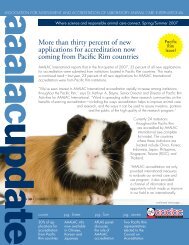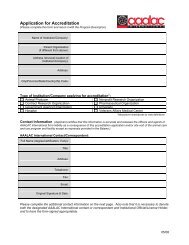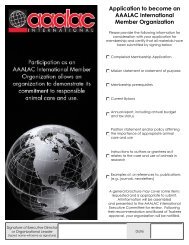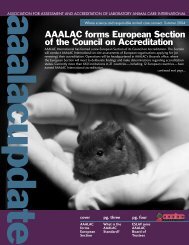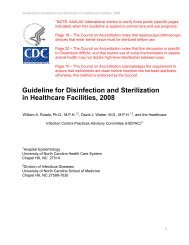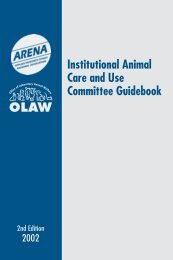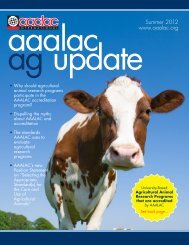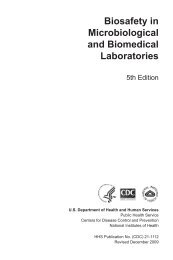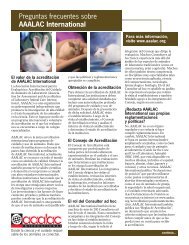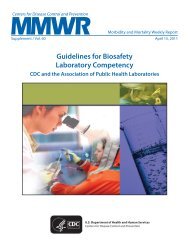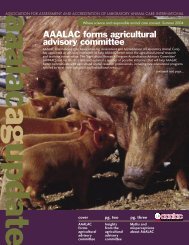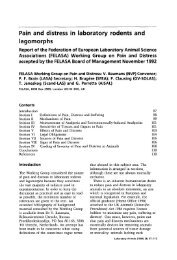4 CHAPTER 1tion Center at <strong>the</strong> National <strong>Agricultural</strong> Library (NRC,1991; CFR, 1992); <strong>and</strong> 5) methods <strong>of</strong> euthanasia. Records<strong>of</strong> participation <strong>in</strong> tra<strong>in</strong><strong>in</strong>g programs should bema<strong>in</strong>ta<strong>in</strong>ed <strong>and</strong> available <strong>for</strong> review as needed.Employees who provide rout<strong>in</strong>e animal care shouldparticipate regularly <strong>in</strong> <strong>in</strong>-service education <strong>and</strong> tra<strong>in</strong><strong>in</strong>grelevant to <strong>the</strong>ir responsibilities. Formal or on-<strong>the</strong>jobtra<strong>in</strong><strong>in</strong>g opportunities should be made available toall technical <strong>and</strong> husb<strong>and</strong>ry support staff, <strong>in</strong>clud<strong>in</strong>gthose who are temporary or part-time employees. Itis recommended that <strong>the</strong> tra<strong>in</strong><strong>in</strong>g program <strong>in</strong>clude <strong>in</strong><strong>for</strong>mationprovided by experts from a broad range <strong>of</strong>discipl<strong>in</strong>es such as animal husb<strong>and</strong>ry, behavior, nutrition,environmental physiology, experimental surgery,veter<strong>in</strong>ary cl<strong>in</strong>ical <strong>and</strong> diagnostic medic<strong>in</strong>e, agriculturaleng<strong>in</strong>eer<strong>in</strong>g, <strong>and</strong> <strong>in</strong>strumentation, <strong>and</strong> o<strong>the</strong>rs asdeemed appropriate. A variety <strong>of</strong> reference materialsis available <strong>for</strong> use <strong>in</strong> tra<strong>in</strong><strong>in</strong>g programs (Kreger, 1995;Underwood, 2005).In addition to hav<strong>in</strong>g <strong>in</strong>-house tra<strong>in</strong><strong>in</strong>g, it is desirable<strong>for</strong> agricultural animal care staff to be pr<strong>of</strong>essionallytra<strong>in</strong>ed or certified. Many states have colleges withaccredited programs <strong>in</strong> veter<strong>in</strong>ary technology (AVMA,2007). Technician <strong>and</strong> technologist certification is availablethrough <strong>the</strong> American Association <strong>for</strong> LaboratoryAnimal Science (AALAS), although that program primarilyemphasizes <strong>the</strong> care <strong>and</strong> use <strong>of</strong> laboratory animalsra<strong>the</strong>r than agricultural animals. Animal scientists wi<strong>the</strong>ducational credentials rang<strong>in</strong>g from <strong>the</strong> baccalaureateto <strong>the</strong> doctorate who seek recognition <strong>of</strong> <strong>the</strong>ir expertise<strong>in</strong> <strong>the</strong> biology <strong>and</strong> production <strong>of</strong> agricultural animals canbe certified by exam<strong>in</strong>ation by <strong>the</strong> American Registry <strong>of</strong>Pr<strong>of</strong>essional Animal Scientists (ARPAS).OCCUPATIONAL HEALTHAn occupational health <strong>and</strong> safety program must beestablished <strong>for</strong> <strong>in</strong>dividuals who work with agriculturalanimals. The program should be consistent with federal,state, <strong>and</strong> local regulations <strong>and</strong> will depend on <strong>the</strong>facilities, research activities, <strong>and</strong> hazards <strong>in</strong>volved. Thedegree <strong>of</strong> participation <strong>of</strong> <strong>in</strong>dividuals <strong>in</strong> <strong>the</strong> programshould be based on an assessment <strong>of</strong> risk by health <strong>and</strong>safety specialists <strong>in</strong>volv<strong>in</strong>g consideration <strong>of</strong> <strong>the</strong> hazardsposed by <strong>the</strong> animals <strong>and</strong> materials used; <strong>the</strong> duration,frequency, <strong>and</strong> <strong>in</strong>tensity <strong>of</strong> exposure; <strong>the</strong> susceptibility<strong>of</strong> <strong>the</strong> personnel; <strong>and</strong> <strong>the</strong> history <strong>of</strong> occupational <strong>in</strong>jury<strong>and</strong> illness <strong>in</strong> <strong>the</strong> particular workplace (Clark, 1993).General guidel<strong>in</strong>es <strong>for</strong> such programs have been publishedby <strong>the</strong> NRC (1997). The program <strong>for</strong> <strong>in</strong>dividualswork<strong>in</strong>g with agricultural animals may <strong>in</strong>clude aphysical exam<strong>in</strong>ation be<strong>for</strong>e placement, periodic medicalevaluations <strong>for</strong> people <strong>in</strong> some job categories, surveillanceto ensure protection from health hazards,<strong>and</strong> provisions <strong>for</strong> treat<strong>in</strong>g illness or <strong>in</strong>jury. The programshould also <strong>in</strong>clude an educational component toteach personnel about agricultural animal diseases <strong>and</strong>zoonoses, physical hazards, personal hygiene, precautionsto be taken by <strong>in</strong>dividuals who are at unusualrisk (e.g., pregnant women), <strong>and</strong> o<strong>the</strong>r considerationsas appropriate (e.g., safety precautions with chemicals,radiation, <strong>and</strong> o<strong>the</strong>r hazardous agents that are part <strong>of</strong>a particular experimental protocol).An appropriate immunization schedule should beadopted. It is important that all agricultural animalcaretakers be immunized aga<strong>in</strong>st tetanus every 10 yearsbased on <strong>the</strong> <strong>in</strong>stitution’s risk assessment. Immunizationsshould be <strong>of</strong>fered to people (be<strong>for</strong>e exposure) whoh<strong>and</strong>le animals <strong>and</strong> risk <strong>in</strong>fection from certa<strong>in</strong> <strong>in</strong>fectiousagents. Prophylactic vacc<strong>in</strong>ations should also be consideredwhen research is be<strong>in</strong>g conducted on <strong>in</strong>fectiousdiseases <strong>for</strong> which effective vacc<strong>in</strong>es are available.Persons work<strong>in</strong>g with farm animals may develop allergies.The occupational safety <strong>and</strong> health programshould identify high-risk areas with potential <strong>for</strong> allergydevelopment. Persons with known allergies should beprovided personal protective equipment or avoid exposureto animals.Physical <strong>in</strong>juries constitute health hazards <strong>for</strong> <strong>in</strong>dividualswork<strong>in</strong>g with agricultural animals. Institutionsshould identify high-risk areas <strong>and</strong> tasks <strong>and</strong> should educateanimal care personnel about methods <strong>for</strong> reduc<strong>in</strong>grisk. Injuries can be m<strong>in</strong>imized by provid<strong>in</strong>g tra<strong>in</strong><strong>in</strong>g <strong>in</strong>proper animal h<strong>and</strong>l<strong>in</strong>g, lift<strong>in</strong>g, <strong>and</strong> equipment use. Accessto first aid <strong>and</strong> medical treatment should be readilyavailable, <strong>and</strong> personnel should be tra<strong>in</strong>ed <strong>and</strong> familiarwith access procedures. Such access may <strong>in</strong>clude readilyavailable <strong>and</strong> properly stocked first-aid kits. Cases<strong>of</strong> animal bites <strong>and</strong> scratches should be documented,<strong>and</strong> tetanus prophylaxis should be considered.<strong>Care</strong>takers work<strong>in</strong>g with agricultural animals <strong>in</strong>closed build<strong>in</strong>gs may develop respiratory problems, <strong>in</strong>clud<strong>in</strong>gchronic <strong>and</strong> irreversible lung damage (Kirkhorn<strong>and</strong> Garry, 2000). Appropriate respiratory protectionshould be provided <strong>for</strong> <strong>the</strong>se <strong>in</strong>dividuals.Zoonoses can also be a serious risk. Personnel (<strong>in</strong>clud<strong>in</strong>ganimal care staff, technicians, <strong>in</strong>vestigators,cl<strong>in</strong>icians, students, ma<strong>in</strong>tenance workers, <strong>and</strong> securitystaff) who have contact with or an opportunity <strong>for</strong> contactwith animals or <strong>the</strong>ir excreta, products, or tissuesshould be made aware <strong>of</strong> hazards that have been identified<strong>and</strong> that are determ<strong>in</strong>ed to be a risk (Acha <strong>and</strong>Szyfres, 2001, 2003). Zoonotic disease <strong>in</strong> animal populationsshould be screened <strong>for</strong> or monitored regularly asappropriate. Table A-1 <strong>in</strong> Appendix 2 <strong>of</strong> this guide lists<strong>the</strong> most common zoonotic diseases found <strong>in</strong> agriculturalanimals <strong>and</strong> <strong>the</strong> means by which <strong>the</strong>y are spread;refer to Chapter 2: <strong>Agricultural</strong> Animal Health <strong>Care</strong> <strong>for</strong>more <strong>in</strong><strong>for</strong>mation.The noise level <strong>in</strong> some animal facilities may sometimesbe high. When personnel are exposed to noiseexceed<strong>in</strong>g federal st<strong>and</strong>ards, appropriate protectionprograms should be implemented (CFR, 1995).Work assignments <strong>and</strong> health records should be a part<strong>of</strong> an occupational health program. Records should be
kept <strong>of</strong> <strong>in</strong>dividual work assignments <strong>and</strong> should <strong>in</strong>clude<strong>the</strong> date <strong>and</strong> time <strong>of</strong> <strong>in</strong>juries or unusual illnesses. Supervisorsshould be <strong>in</strong>structed to fully <strong>in</strong><strong>for</strong>m personnel<strong>of</strong> potential health hazards, <strong>and</strong> personnel should be <strong>in</strong>structedto notify <strong>the</strong>ir supervisor if a zoonosis occurs.SPECIAL CONSIDERATIONSHazardous MaterialsThe use <strong>of</strong> certa<strong>in</strong> hazardous biological, chemical,or physical materials necessitates compliance with applicablelaws <strong>and</strong> regulations as well as compliancewith guidel<strong>in</strong>es issued by grant<strong>in</strong>g agencies <strong>and</strong> organizations.Institutions should have written policiesgovern<strong>in</strong>g experimentation with hazardous materials<strong>and</strong> should ensure that staff members conduct<strong>in</strong>g <strong>and</strong>support<strong>in</strong>g research projects <strong>in</strong>volv<strong>in</strong>g hazardous materialsare qualified to assess <strong>the</strong> dangers to animals<strong>and</strong> humans <strong>and</strong> are capable <strong>of</strong> select<strong>in</strong>g appropriatesafeguards. Special facilities <strong>and</strong> equipment may be required<strong>for</strong> certa<strong>in</strong> hazardous materials, <strong>and</strong> additionalrequirements exist <strong>for</strong> those biological materials ortox<strong>in</strong>s deemed as select agents by federal law. Fur<strong>the</strong>r<strong>in</strong><strong>for</strong>mation about recommended practices <strong>and</strong> procedurescan be found <strong>in</strong> publications by CDC <strong>and</strong> NIH(2000, 2007), CFR (2005), <strong>and</strong> NRC (1997).Genetically Eng<strong>in</strong>eered <strong>and</strong> Cloned <strong>Animals</strong>INSTITUTIONAL POLICIESAs advancements <strong>in</strong> research drive <strong>the</strong> discovery<strong>and</strong> development <strong>of</strong> new technologies, specific considerationsmay need to be made <strong>for</strong> <strong>the</strong> care <strong>and</strong> use <strong>of</strong>agricultural animals <strong>in</strong> research <strong>and</strong> teach<strong>in</strong>g. Institutions,researchers, <strong>and</strong> IACUCs should assure that assessment<strong>of</strong> animal care <strong>and</strong> use protocols reflects differences<strong>in</strong> various animal technologies. <strong>Guide</strong>l<strong>in</strong>es <strong>for</strong>research <strong>in</strong>volv<strong>in</strong>g genetically eng<strong>in</strong>eered (GE) animalsor livestock clones do not differ materially from thosethat apply to conventional animals used <strong>in</strong> research exceptunder special conditions. The published scientificliterature has not established <strong>the</strong> need <strong>for</strong> unique guidel<strong>in</strong>es.The general st<strong>and</strong>ards <strong>of</strong> care associated with GEor cloned agricultural animals should be <strong>the</strong> same asthose applied to all agricultural animals <strong>in</strong> research unless<strong>the</strong> specific genetic modification requires an alteration<strong>in</strong> management with<strong>in</strong> <strong>the</strong> research environment tospecifically facilitate animal welfare.In <strong>the</strong> future, <strong>in</strong>stitutions may wish to establishguidel<strong>in</strong>es used <strong>in</strong> keep<strong>in</strong>g with federal, state, <strong>and</strong> localgovernment regulatory requirements. The animalbiotechnology <strong>in</strong>dustry recently released guidel<strong>in</strong>es <strong>for</strong>research <strong>and</strong> development with GE animals as a stewardshipprogram <strong>for</strong> GE animals (Biotechnology IndustryOrganization, 2009). The BIO Guidance provides<strong>in</strong><strong>for</strong>mation <strong>for</strong> <strong>the</strong> development <strong>and</strong> implementation <strong>of</strong>stewardship programs <strong>for</strong> all <strong>in</strong>stitutions <strong>and</strong> researchersthat plan to engage <strong>in</strong> research <strong>and</strong> development,<strong>and</strong> possible commercialization, <strong>of</strong> GE animals.<strong>Research</strong> Involv<strong>in</strong>g Genetic Eng<strong>in</strong>eer<strong>in</strong>g <strong>of</strong><strong>Agricultural</strong> <strong>Animals</strong>Genetic eng<strong>in</strong>eer<strong>in</strong>g <strong>of</strong> agricultural animals is <strong>the</strong>direct manipulation <strong>of</strong> an organism’s genes, <strong>in</strong>clud<strong>in</strong>gheritable <strong>and</strong> nonheritable recomb<strong>in</strong>ant DNAconstructs. Genetic eng<strong>in</strong>eer<strong>in</strong>g is different from traditionalbreed<strong>in</strong>g, <strong>in</strong> which <strong>the</strong> organism’s genes aremanipulated <strong>in</strong>directly. The genetic eng<strong>in</strong>eer<strong>in</strong>g <strong>of</strong> agriculturalanimals has been extensively reviewed (National<strong>Research</strong> Council, 2002; Council on <strong>Agricultural</strong>Science <strong>and</strong> Technology, 2003, 2007, 2009; Wheeler,2007). All GE animals <strong>in</strong> <strong>the</strong> United States are <strong>in</strong> research<strong>and</strong> development, with currently only one approvedproduct from a GE agricultural animal <strong>in</strong> <strong>the</strong>United States. Animal welfare <strong>for</strong> GE animals used <strong>in</strong>research is regulated by law, regulations, <strong>and</strong> guidel<strong>in</strong>es<strong>of</strong> <strong>the</strong> US Department <strong>of</strong> Agriculture (USDA) <strong>and</strong> <strong>the</strong>National Institutes <strong>of</strong> Health (NIH). For animals used<strong>in</strong> biomedical research, <strong>the</strong>ir needs <strong>for</strong> <strong>the</strong>rmal com<strong>for</strong>t,humidity control, floor space, <strong>and</strong> husb<strong>and</strong>ry practicesshould be based on <strong>the</strong> per<strong>for</strong>mance st<strong>and</strong>ards outl<strong>in</strong>ed<strong>in</strong> this Ag <strong>Guide</strong>. <strong>Animals</strong> <strong>in</strong> certa<strong>in</strong> biomedical sett<strong>in</strong>gs<strong>and</strong> with certa<strong>in</strong> genetic backgrounds may havespecial requirements that should be understood so thatanimals are com<strong>for</strong>table. The same per<strong>for</strong>mance st<strong>and</strong>ardsthat <strong>in</strong>dicate adequate animal welfare <strong>in</strong> an agriculturalsett<strong>in</strong>g will apply <strong>for</strong> animals <strong>in</strong> a biomedicalsett<strong>in</strong>g. Welfare <strong>of</strong> animals used <strong>in</strong> biomedical researchis currently regulated by law, regulations, <strong>and</strong> guidel<strong>in</strong>es<strong>of</strong> <strong>the</strong> USDA <strong>and</strong> <strong>the</strong> NIH. Specific <strong>in</strong><strong>for</strong>mationcan be obta<strong>in</strong>ed by review<strong>in</strong>g <strong>the</strong> NIH guidel<strong>in</strong>es <strong>for</strong>research <strong>in</strong>volv<strong>in</strong>g recomb<strong>in</strong>ant DNA molecules (NIH,2002) <strong>and</strong> <strong>the</strong> Animal Welfare Act regulations overseenby USDA. Fur<strong>the</strong>rmore, <strong>the</strong> US Food <strong>and</strong> Drug Adm<strong>in</strong>istration(FDA) recently released guidance <strong>for</strong> <strong>in</strong>dustrythat may be helpful <strong>in</strong> <strong>the</strong> conduct <strong>of</strong> research with GEanimals (FDA, 2009).<strong>Research</strong> Involv<strong>in</strong>g Clon<strong>in</strong>g <strong>of</strong> <strong>Agricultural</strong><strong>Animals</strong>Animal clon<strong>in</strong>g is an assisted reproductive technology(FDA, 2008) similar to artificial <strong>in</strong>sem<strong>in</strong>ation, embryotransfer, <strong>and</strong> <strong>in</strong> vitro fertilization. The current techniqueused <strong>for</strong> animal clon<strong>in</strong>g is somatic cell nucleartransfer (SCNT). In research, GE animals may be producedus<strong>in</strong>g SCNT. There are no published US guidel<strong>in</strong>es<strong>for</strong> unique requirements regard<strong>in</strong>g <strong>the</strong> care <strong>and</strong>use <strong>of</strong> animal clones <strong>in</strong> research. The care <strong>and</strong> use <strong>of</strong>animal clones <strong>in</strong> research does not differ from care provided<strong>for</strong> conventional animals to assure good animalwelfare <strong>and</strong> animal well-be<strong>in</strong>g. In addition, because <strong>the</strong>progeny <strong>of</strong> animal clones are not clones, clearly progenydo not require special consideration.5
- Page 1 and 2: Guide for the Care and Useof Agricu
- Page 3 and 4: Guide Revision Committees for the F
- Page 5 and 6: Chapter 6: Beef Cattle 61Facilities
- Page 7: PrefaceThis is the third edition of
- Page 10 and 11: 2 CHAPTER 1The IACUC should meet at
- Page 14 and 15: 6 CHAPTER 1Disposition of Animal Cl
- Page 16 and 17: Chapter 2: Agricultural Animal Heal
- Page 18 and 19: 10 CHAPTER 2and behavioral health e
- Page 20 and 21: 12 CHAPTER 2care attendants or rese
- Page 22 and 23: 14 CHAPTER 2exposed to these chemic
- Page 24 and 25: Chapter 3: Husbandry, Housing, and
- Page 26 and 27: 18 CHAPTER 3Most agricultural anima
- Page 28 and 29: 20 CHAPTER 3gases, particulates, an
- Page 30 and 31: 22 CHAPTER 3in pairs or groups when
- Page 32 and 33: 24 CHAPTER 3screened with 1.3-cm (0
- Page 34 and 35: 26 CHAPTER 3priate, and institution
- Page 36 and 37: 28 CHAPTER 3ings and Deliberations.
- Page 38 and 39: Chapter 4: Environmental Enrichment
- Page 40 and 41: 32 CHAPTER 4(Feh and de Mazieres, 1
- Page 42 and 43: 34 CHAPTER 4Substrate: The provisio
- Page 44 and 45: 36 CHAPTER 4mize regrouping and soc
- Page 46 and 47: 38 CHAPTER 4not especially attracte
- Page 48 and 49: 40 CHAPTER 4Croney, C. C., K. M. Ad
- Page 50 and 51: 42 CHAPTER 4Meunier-Salaün, M. C.,
- Page 52 and 53: 44 CHAPTER 4Wilson, S. C., F. M. Mi
- Page 54 and 55: 46 CHAPTER 5dling facility in the f
- Page 56 and 57: 48 CHAPTER 5Table 5-1. Visual distr
- Page 58 and 59: 50 CHAPTER 5Animals should be handl
- Page 60 and 61: 52 CHAPTER 5be given during conditi
- Page 62 and 63:
54 CHAPTER 5mercial broiler farms,
- Page 64 and 65:
56 CHAPTER 5The condition of the an
- Page 66 and 67:
58 CHAPTER 5Arnold, G. W. 1977. An
- Page 68 and 69:
60 CHAPTER 5for veterinary and husb
- Page 70 and 71:
62 CHAPTER 6managers of confined ca
- Page 72 and 73:
64 CHAPTER 6Cold housing can be pro
- Page 74 and 75:
66 CHAPTER 6HUSBANDRYAdequate care
- Page 76 and 77:
68 CHAPTER 6ately to perform a caes
- Page 78 and 79:
70 CHAPTER 6minimum amount of time
- Page 80 and 81:
72 CHAPTER 6Ensminger, M. E. 1970.
- Page 82 and 83:
Chapter 7: Dairy CattleDairy cattle
- Page 84 and 85:
76 CHAPTER 7Table 7-1. Recommended
- Page 86 and 87:
78 CHAPTER 7ties should be provided
- Page 88 and 89:
80 CHAPTER 7quent feeding, and exce
- Page 90 and 91:
82 CHAPTER 7hanced sensitivity to h
- Page 92 and 93:
84 CHAPTER 7effective for removing
- Page 94 and 95:
86 CHAPTER 7Albright, J. L. 1978. S
- Page 96 and 97:
88 CHAPTER 7Murphy, M. R., C. L. Da
- Page 98 and 99:
Chapter 8: HorsesMost horses are us
- Page 100 and 101:
92 CHAPTER 8Temperature and Ventila
- Page 102 and 103:
94 CHAPTER 8tritional programs for
- Page 104 and 105:
96 CHAPTER 8WaterClean water should
- Page 106 and 107:
98 CHAPTER 8bots (Gastrophilus inte
- Page 108 and 109:
100 CHAPTER 8STANDARD AGRICULTURALP
- Page 110 and 111:
102 CHAPTER 8of Animals. C. McGowan
- Page 112 and 113:
104 CHAPTER 9dom of movement, runni
- Page 114 and 115:
106 CHAPTER 92006). Developing bree
- Page 116 and 117:
108 CHAPTER 9Table 9-3. Minimum fee
- Page 118 and 119:
110 CHAPTER 9Table 9-7. Minimum dri
- Page 120 and 121:
112 CHAPTER 9Table 9-10. Minimum fl
- Page 122 and 123:
114 CHAPTER 9Table 9-12. Minimum fl
- Page 124 and 125:
116 CHAPTER 9ery effort should be m
- Page 126 and 127:
118 CHAPTER 9guides, available from
- Page 128 and 129:
120 CHAPTER 9nutritive pecking decr
- Page 130 and 131:
122 CHAPTER 9rapidly fragmented by
- Page 132 and 133:
124 CHAPTER 9Brambell, F. W. R. 196
- Page 134 and 135:
126 CHAPTER 9Hughes, B. O., and M.
- Page 136 and 137:
128 CHAPTER 9chickens grown with tw
- Page 138 and 139:
130 CHAPTER 10Table 10-1. Recommend
- Page 140 and 141:
132 CHAPTER 10prevented or minimize
- Page 142 and 143:
134 CHAPTER 10and well-being (Matte
- Page 144 and 145:
136 CHAPTER 10via colostrum (de la
- Page 146 and 147:
138 CHAPTER 10thoroughly at the beg
- Page 148 and 149:
140 CHAPTER 10Ames, D. R., J. E. Ne
- Page 150 and 151:
142 CHAPTER 102006. Semen and repro
- Page 152 and 153:
144 CHAPTER 11Table 11-1. Recommend
- Page 154 and 155:
146 CHAPTER 11vided in the creep ar
- Page 156 and 157:
148 CHAPTER 11Table 11-2. Minimum f
- Page 158 and 159:
150 CHAPTER 11are kept in small gro
- Page 160 and 161:
152 CHAPTER 11sonable to consolidat
- Page 162 and 163:
154 CHAPTER 11Blackshaw, J. K., F.
- Page 164 and 165:
156 CHAPTER 11populations structure
- Page 166 and 167:
Appendix 2Table A-1. Zoonotic disea
- Page 168 and 169:
IndexAAABP (American Association of
- Page 170 and 171:
162 INDEXcold climates. See also te
- Page 172 and 173:
164 INDEXdairy, 137disbudding of, 1
- Page 174 and 175:
166 INDEXmisters, 19mites, 98Model
- Page 176 and 177:
168 INDEXin horse stalls, 90in poul



